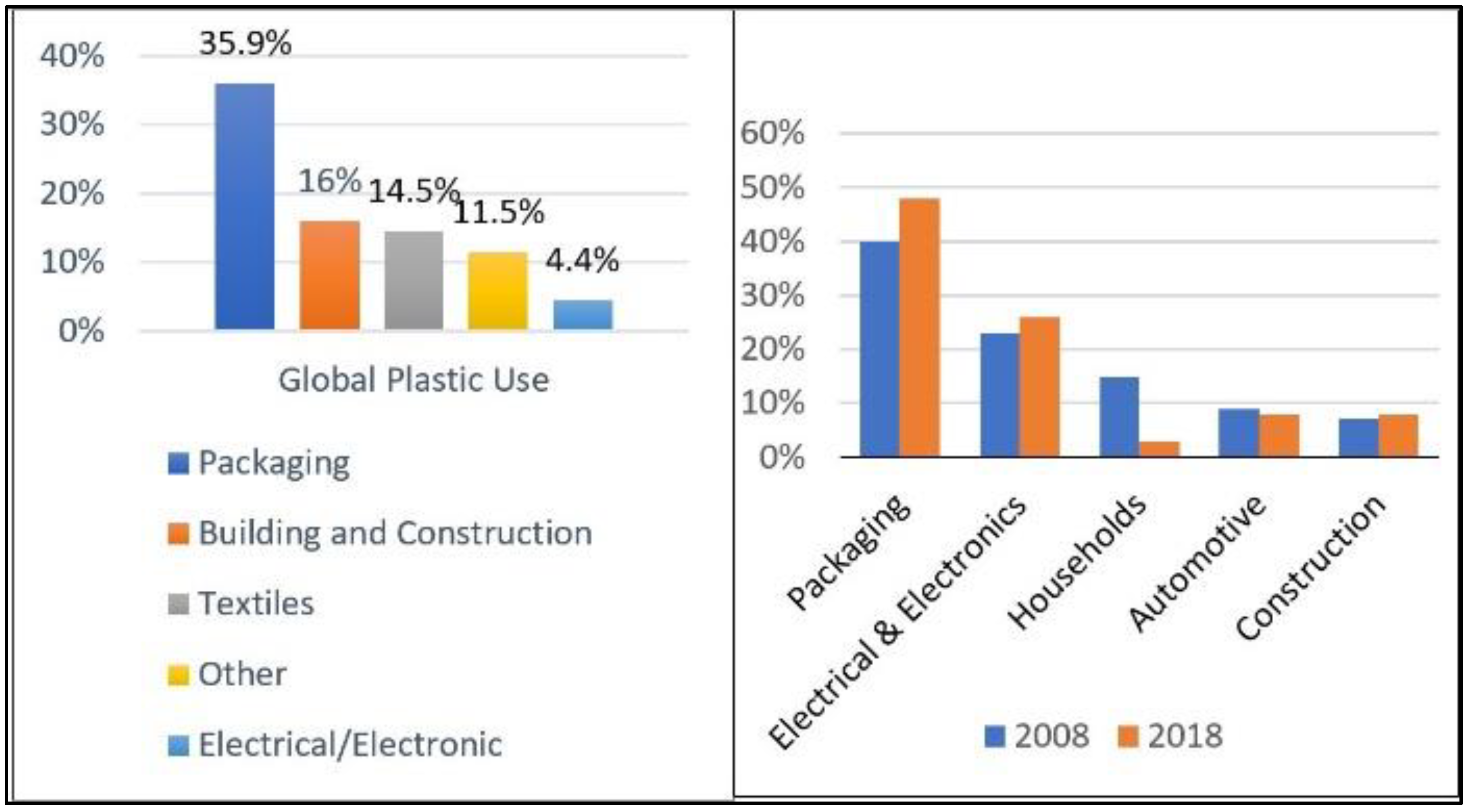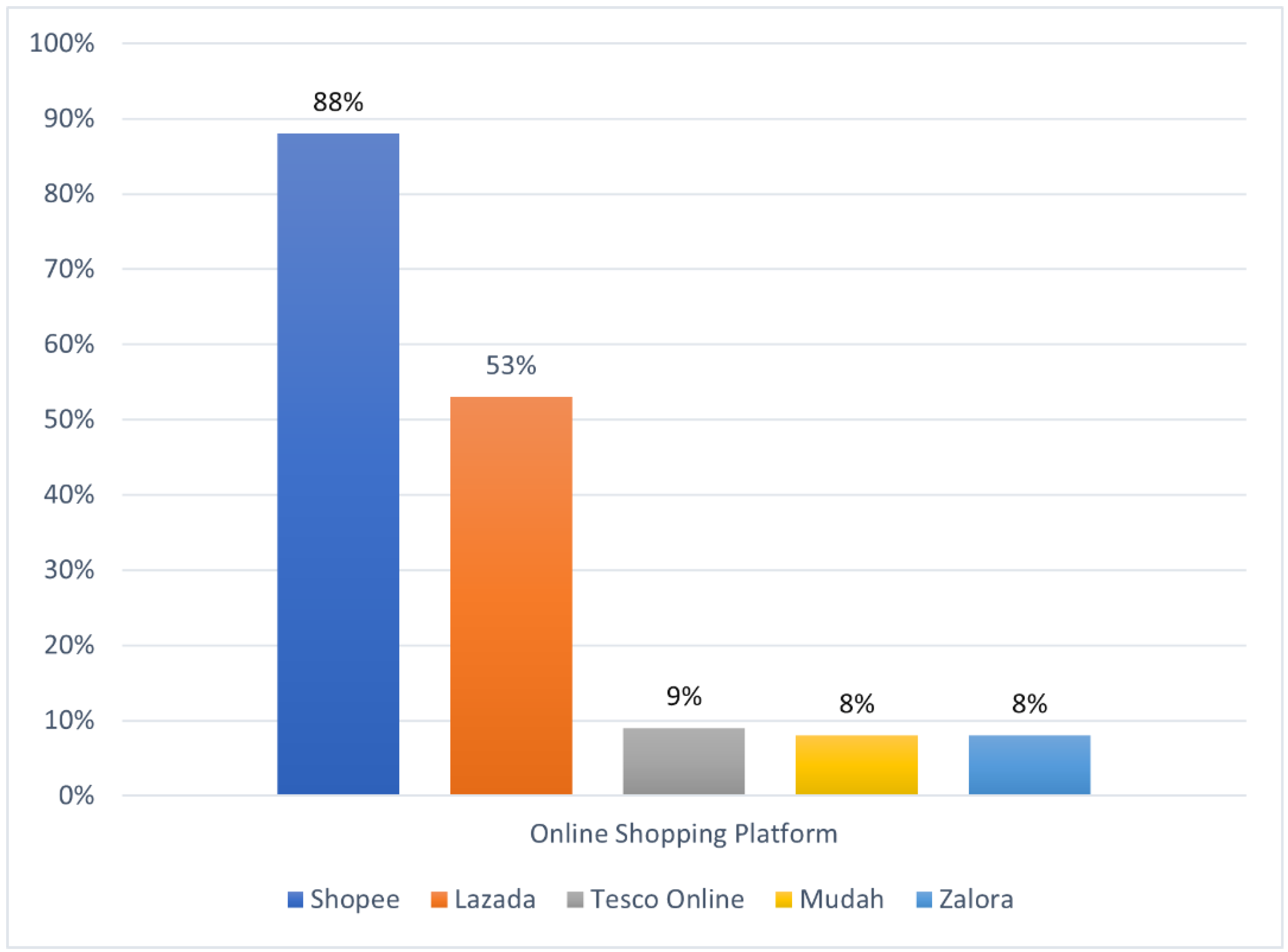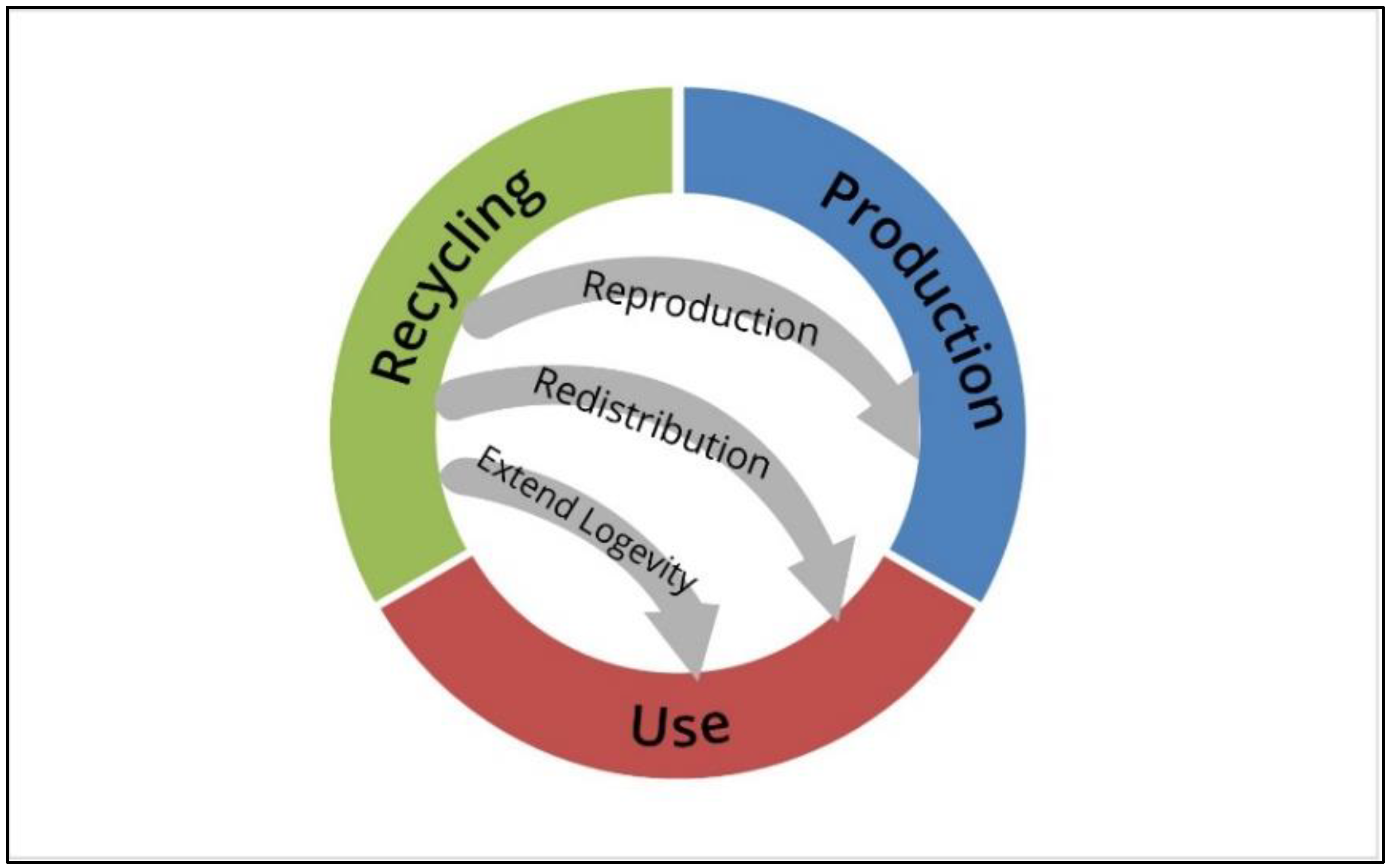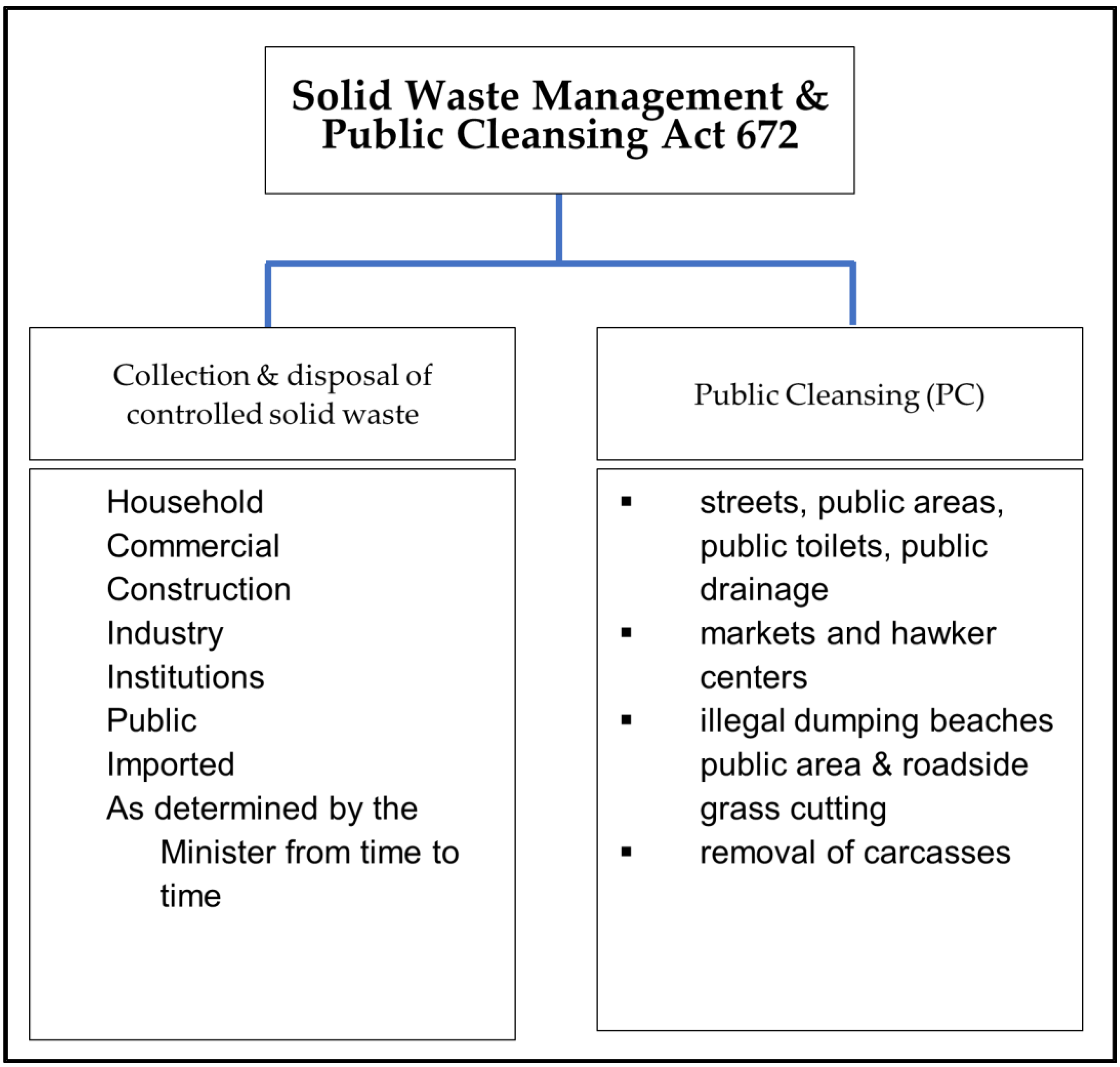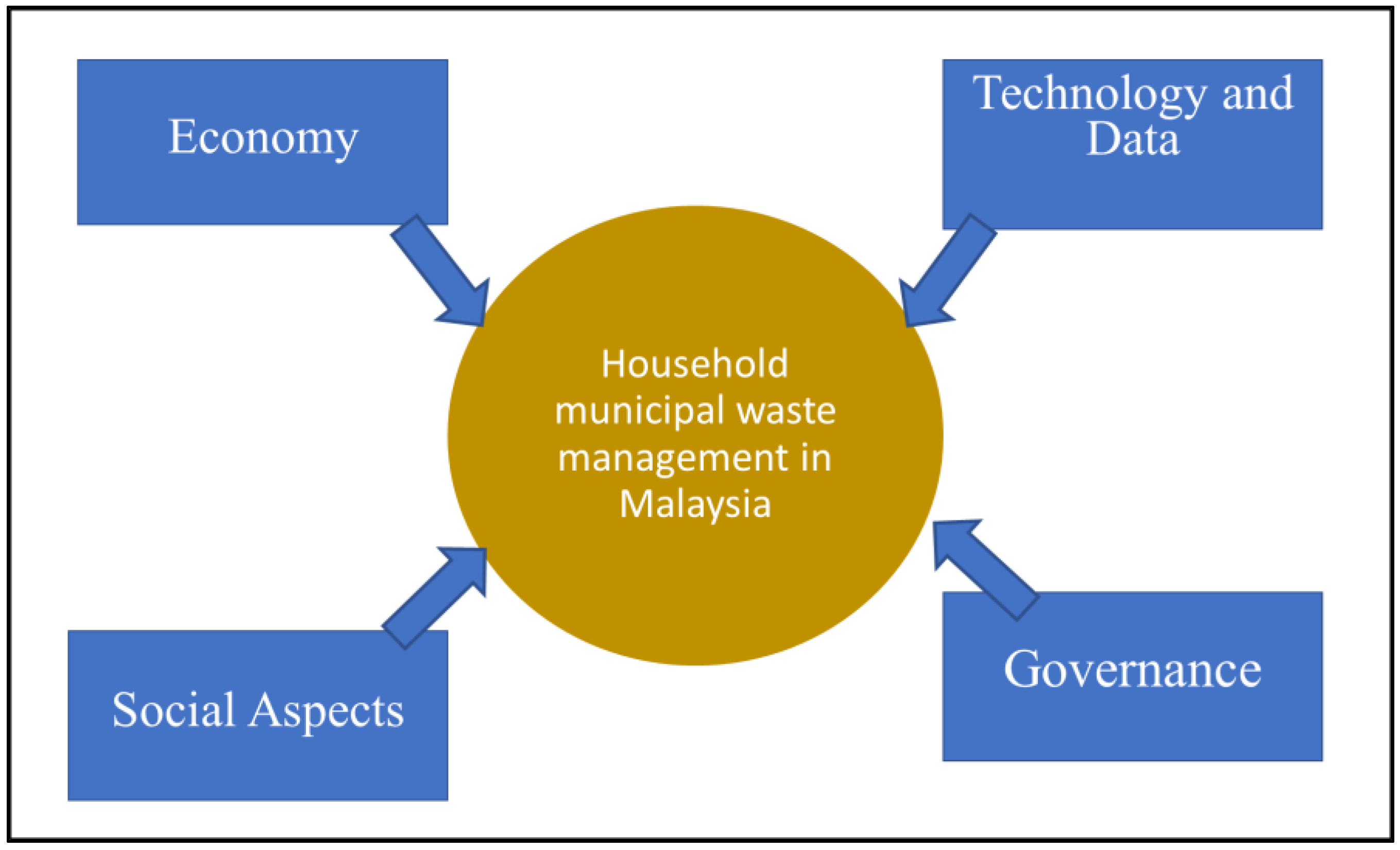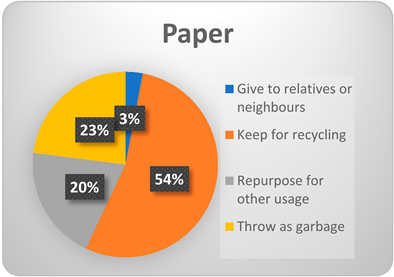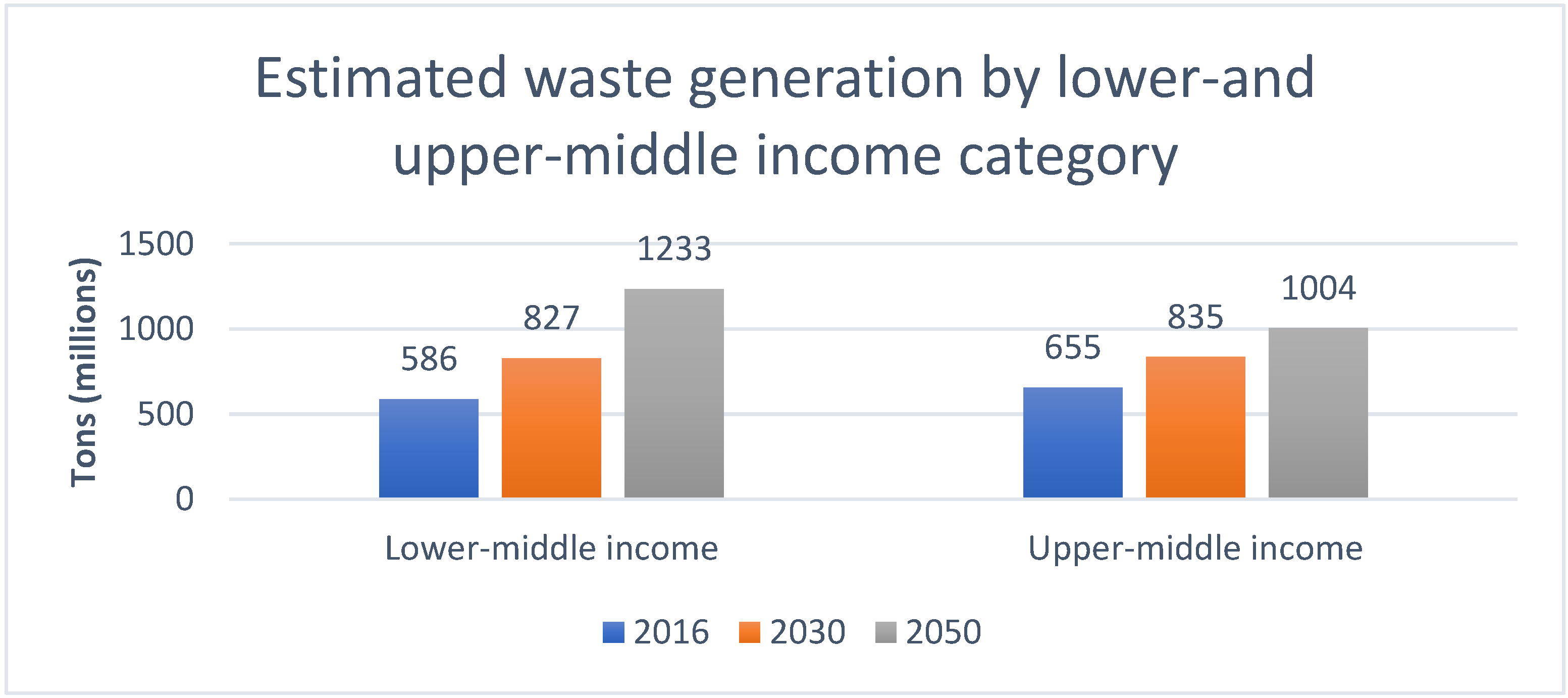| No | Authors | Title | Objective | Future Suggestions | Success Factors and Practices | Key Findings |
| A1 | [42] | “Impact of perceived food accessibility on household food waste behaviors: A case of the Klang Valley, Malaysia” | “Perceived food accessibility, measured in terms of perceived time and perceived effort, and its impact on household food waste” | - -
“Over purchase are to prevent wastage and waste creation - -
Recycling behavior and preventive behavior are needed”
| - -
“Changing leftover routines, reducing shopping trips per week.”
| - -
“Three significant paths are found in the model connecting food waste with effort levels, environmental concern, and price importance.” - -
“Policymakers may consider improving access to food sources to reduce household food purchase efforts.”
|
| A2 | [43] | “Resilient Melaka—Creating a striving, livable and smart Melaka” | “Resilient Melaka sets a vision for “a vibrant city, where smart governance, collective leadership, sustainable mobility and protective infrastructure supports a thriving, healthy community that is proud of Melaka’s outstanding universal values as a world heritage city.”” | - -
“Green City Action Plan (2017–2030)” - -
“Promote sustainable ways awareness campaign” - -
“Creating a Circular Economy for solid waste action” - -
Improving Solid Waste Collection Systems Action
| - -
“This strategy was developed in collaboration with over 320 city stakeholders from the government, private sector, academia and the general public (i.e., Online engagement surveys and social media, Workshops, Discussions and Interviews)”
| - -
“This report builds upon existing strategies by highlighting expanding initiatives to include a resilience approach and identifying new opportunities to incorporate disaster risk management and climate change adaptation in the city’s development.”
|
| A3 | [44] | “Community Participation and Performance of Waste Segregation Program in Malacca: Towards Sustainable Waste Management” | “This paper reviews the current practice and challenges of community’s participation on waste segregation program in Jasin Malacca since 2015–2017 towards achieving the Sustainable city in year 2022.” | - -
“At the authority level, provision of integrated structure and stakeholders should be formulated by providing the necessary facilities, including funding equipment, incentives and waste disposal area.” - -
“The local authority should play their role in working closely with the community committees to address feedback and problems encountered during the period execution.”
| - -
“Various Waste Separation at Source awareness programs were initiated by the local authority agencies such as SWCorp and Malacca Green Technology Corporation (PTHM).” - -
“Many workshops and programs in educating the kids in school have been implemented and to nurture the “Recycling Culture” into the heart of younger generations.”
| - -
“Through various efforts and campaigns on waste separation at source, the performance has steadily increased from 2015 to 2017. It is expected that the initiative shall be rigorously promoted as to achieve the 30% recycling rate in 2020.”
|
| A4 | [45] | “Making a Case for Zero Waste: Laying the Groundwork for Zero Waste” | “To discuss Penang state’s waste segregation challenges and future expectations of Penang’s zero waste program.” | - -
“Penang will continue to strive for a low-carbon city by 2022 by increasing the recycling rate from 42% to 70% and reducing their landfill-bound waste by 50%.”
| - -
“Awareness is important among all the communities to be responsible for their disposal of waste.”
| - -
“A public consultation on Budget Dialogue in 2012 with the stakeholders cleared one thing: all of them prioritized cleanliness. Cleanliness includes a vast array of things; and recycling, composting, and upcycling are inseparable aspects of it.”
|
| A5 | [19] | “Stakeholder Consultation on Penang’s Green initiatives: Solving Plastic Pollution at Source” | “To discuss and deliberate on the various green initiatives that have taken place thus far in relation to tackling plastic pollution at source in Penang, as well as planning the way forward for 2020 including the know-how in embedding Circular Economy solutions within the Island and mainland’s ecosystem.” | - -
“Hoping to enforce ‘Single-use plastics ban’ by 2023.” - -
“Continue education, monitoring & enforcement of WSAS” - -
“Introduce incentives/recognition for WSAS for plastic and other materials for recycling.” - -
“Polluter Pays Principle and Waste Directory should be adopted in the WSAS Policy.” - -
“A case study for long-term community behavioral change requires the involvement of various stakeholders.”
| - -
“Applying WSAS policy” - -
“Total ban on polystyrene packaging, No Plastic Day Campaign, and No Single-use Plastic Campaign were implemented in order to divert and reduce the number of waste.” - -
“Many green initiatives were done by local authorities to reduce the usage of single-use plastics included educational talks, distribution of recycled bags at Bazar Ramadan during the fasting month, and distribution of “Say No to Single-Use Plastics” posters to food and beverage outlets on the island.” - -
“Initiatives by organizations in supporting Penang’s state vision and protecting the environment.”
| - -
“The discussions and key takeaways during the stakeholder consultation provided valuable inputs to the project team to further develop the case study according to the Terms of Reference and how to get multi-stakeholders on board.”
|
| A6 | [46] | “Public Survey: The Impacts of Movement Control Order (MCO) Towards Waste Generation in Penang Island” | “To investigate the impacts of MCO (Malaysia’s lockdown) influence on household waste generation and consumer purchasing behavior.To provide data and insights in order to assist policymakers and other related agencies to better deal with similar crises in the future.” | - -
“Suggestions from respondents to increase the number of recycling bins at public areas.” - -
“Medical waste or hazardous waste bins should be set up in public areas.” - -
“Incentives from government and businesses could help motivate the public to practise 3R.”
| - -
“It is essential to heed public opinions as they allow the identification of critical elements that form the foundation in developing effective strategies to tackle this problem.”
| - -
“52% of respondents noticed waste generated in home has increased” - -
“MCO had no influence on Waste segregation practice” - -
“There is general agreement (51% ) about MCO causing the increase of single-use plastics” - -
“The use of face masks has become a norm.” - -
“COVID-19 pandemic has remarkably changed consumer behavior.”
|
| A7 | [12] | “Microplastic Pollution and Health and Relevance to the Malaysia’s Roadmap to Zero Single-Use Plastics 2018–2030” | “To discuss the rising threat from microplastics and potential impact to human health.” | - -
“It is vital that each relevant stakeholder, including the federal government, state government, non-government agencies, manufacturers and the general public work together in order to achieve the goal in 2030.”
| - -
“Plastic straws, wrappers and cutlery should be banned and replaced with more eco-friendly materials.”
| - -
“Low rate of recycling plastic waste, lack of awareness on sustainable behaviors and habits, lack of integrated waste management, inadequate biodegradability products and high cost of plastic alternatives, and lack of cooperation and enforcement from relevant governmental stakeholders.”
|
| A8 | [47] | “Extended Producer Responsibility (EPR) in Malaysia—Towards a Sustainable Waste Management System” | “To discuss the opportunities of EPR legal system in Malaysia, especially in supporting management of plastic solid waste” | - -
“Governance must be strengthened to form a strong foundation. - -
Communications & awareness are vital to create a paradigm shift in mindset.” - -
“Polluter-pay-principle instruments need to be further explored.” - -
“Government must set a good example by implementing GGP.” - -
“3R initiatives require strong inter-Agency coordination and collaboration.” - -
“Clear and definitive roles of stakeholders ranging from manufacturers of packaging” - -
“Enhancement of recycling programs through sustainable extensive public education and publicity campaigns.”
| - -
“The 11th Malaysia Plan (2016–2020) establishes guiding principles for effective and sustainable waste management for 2016–2020, focusing on green growth for sustainability and resilience. A clear path forward for improving Malaysia’s solid waste management system, from changing societal mindsets to enhancing waste database collection systems and mandating or strengthening a single governing body to implement and enforce relevant legislation to ensure waste optimization and minimization in Malaysia.”
| - -
“Formation of a Producer Responsibility Organization (PRO) responsible for the organization of all tasks associated to the proposed EPR system.” - -
“A sustainable regulatory framework on EPR covering for example specific types of goods including packaging products, on deposit system, waste disposal tax and amount of waste to be utilized in production and collection, sorting and recycling targets.” - -
“Material or of packaging, consumer goods companies, distributors, retailers, consumers, waste management operators, government and other public authorities including local municipalities.” - -
“Strengthening of institutional capacities, technical and skilled staff and sufficient financial resources to monitor and control implementation of EPR system.” - -
“Charging of fees based on the packaging’s degree of recyclability.”
|
| A9 | [48] | “Plastic Waste: Environmental Legal Issues and Policy Law Enforcement for Environmental Sustainability” | “To discuss the environmental issues that are related to plastic waste. Especially due to people’s habit, changing entrenched habits and law enforcement at the empirical level.” | - -
“Participation of stakeholders is essential in establishing policies on the provision of the protection of environmental sustainability to ensure the fulfill of the rights of citizens.”
| - -
“Restricting the use of single-use plastic packaging (food and beverages) for the coastal community and visitors.” - -
“Practicing the habit of proper garbage disposal, i.e., providing trash bins, sorting types of waste (plastic waste and other waste).” - -
“Banning all people from dumping litter at the beach.” - -
“Imposing sanctions for those who violate the rules.”
| - -
“Preventive approach is important to keep out from the undesirable results caused by the waste” - -
“The absence of imposing sanctions turns out to be a problem in plastic waste reduction and management.”
|
| A10 | [49] | “Malaysia Moving Towards a Sustainability Municipal Waste Management” | “This paper aims to discuss the application of energy recovery from municipal solid waste in Malaysia.” | - -
“The government should put effort into solving the current issue by promoting recycling in public, enforcing the legislation, and approaching new technologies for better solid waste management practice in the future.”
| - -
“The recovery system and refuse-derived fuel plant achieved expectations.”
| - -
“The solid waste management practices lacking separation and recycling sources become an obstacle for development.” - -
“The application of (waste to energy) WtE technologies, especially incineration, is unavoidable in the future in order to reduce the volume of waste being disposed in the landfill.”
|
| A11 | [50] | “Forecasting Solid Waste Generation in Negeri Sembilan and Melaka” | “The solid waste produced in Negeri Sembilan and Melaka is forecasted to one year ahead and to see whether the landfills in both states are still able to accommodate the solid waste produced.” | - -
“Restrictions on the use of plastic bags and food containers need to be tightened.” - -
“The government must enforce instructions on the use of grocery bags - -
Awareness of 3Rs in society needs to be increased to save the earth from solid waste.”
| - -
“ARIMA model in forecasting the solid waste generation is effective to forecast the waste and enable the public to be aware of the alarming increase of waste.”
| - -
“The estimated solid waste generation for both states also is approaching the maximum landfill capacity, and this issue should be taken seriously so that environmental damage can be reduced.”
|
| A12 | [51] | “Waste management system fraud detection using machine learning algorithms to minimize penalties avoidance and redemption abuse” | “To analyze a waste management system and develop a machine learning model to detect online fraud in the system.” | - -
“The proposed machine learning models can be a solution that can provide the recycling organizations with the ability to detect fraudulent activities during their waste collection process activities.”
| - -
“Smart waste management tools system able to track the recycling activities and assist communities in recycling.”
| - -
“Machine learning approaches are useful in detecting fraud of waste management with high accuracy.”
|
| A13 | [16] | “The plastic waste problem in Malaysia: management, recycling and disposal of local and global plastic waste” | “Outlines the current state of plastic waste production and management in Malaysia, including options for landfill, recycling and incineration.” | - -
“It provides data on the volume and risks of plastic waste in the country (i.e., microplastics, landfill, and incineration), summarizes key plastic waste management policy initiatives (including plastic alternatives such as biodegradable plastics), and identifies key impediments to these initiatives’ success.”
| - -
“While resolving the issues raised by plastic in Malaysia would require persistent effort on a variety of fronts, positive experiences in other nations provide some reason for optimism.”
| - -
“The paper closes by discussing options for and constraints on the switch to biodegradable alternatives and proposes a model of plastic management based on a circular economy approach and solid waste management hierarchy.”
|
